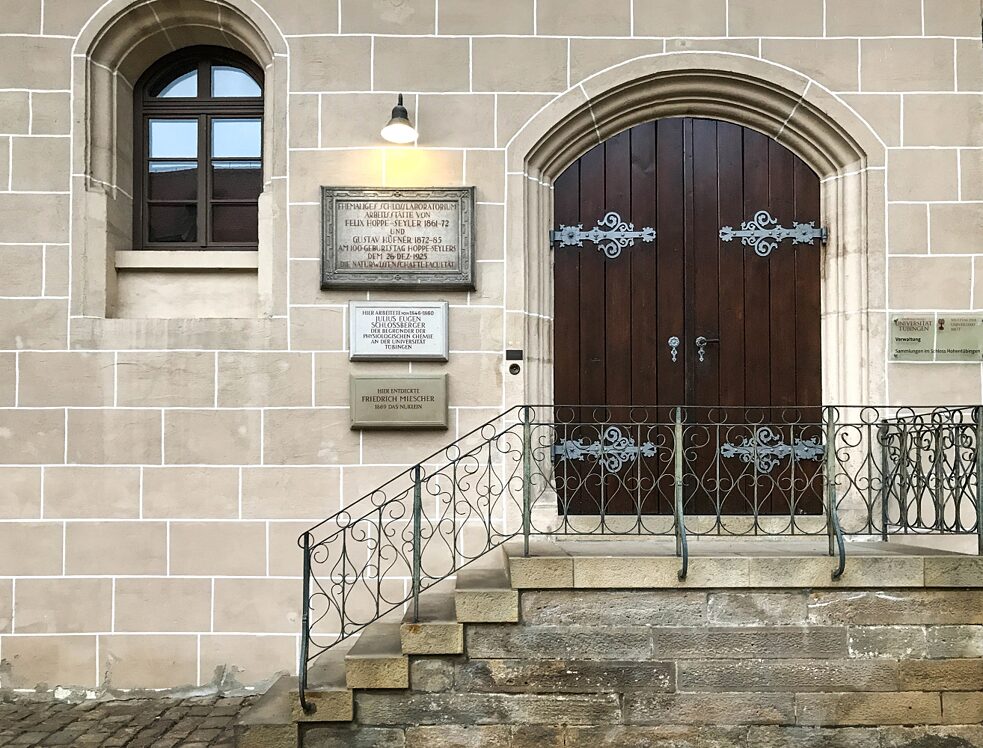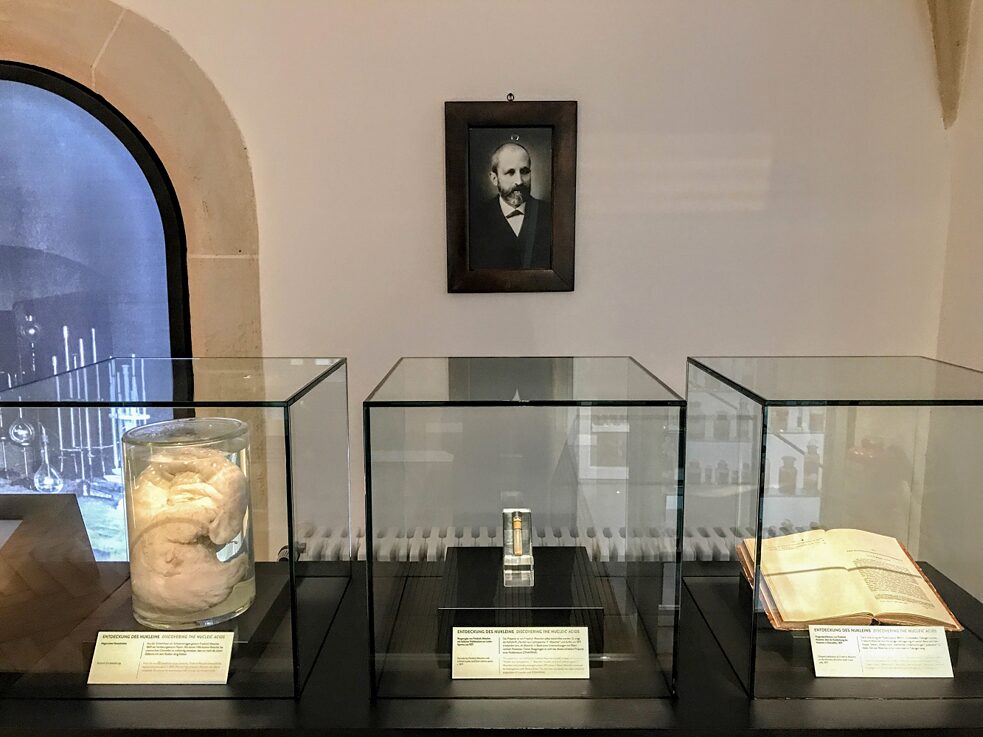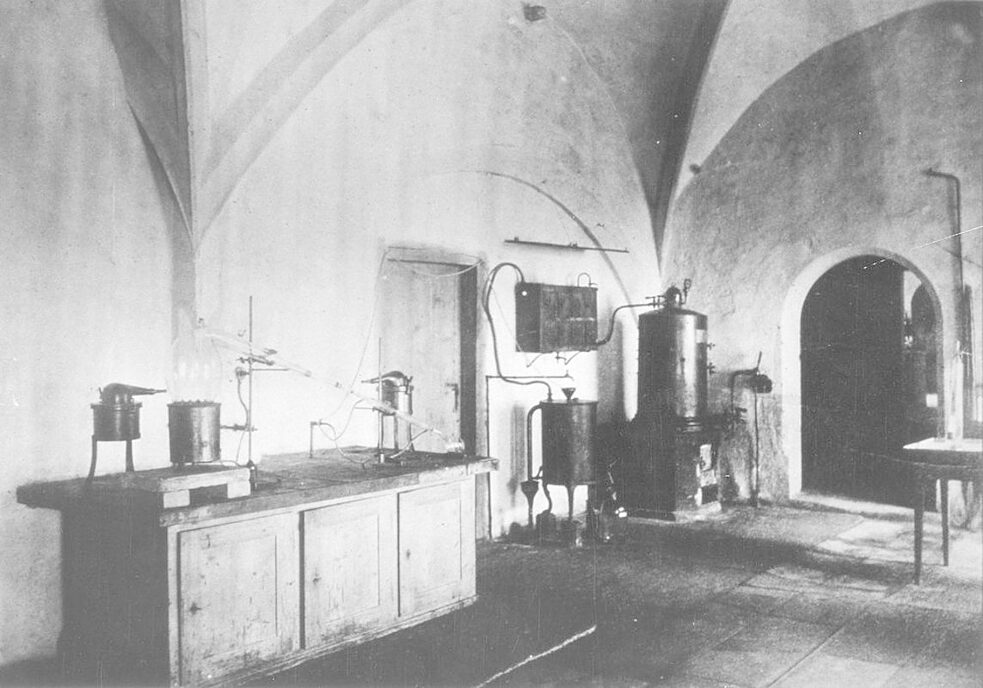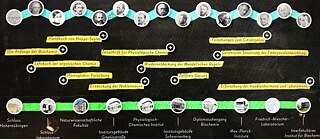Groundbreaking random product
DNA Discovery in a Kitchen
We’ve grown up believing microscopic scientific discoveries require sparkling clean environments. But 150 years ago, an important discovery of life’s building block took place in not-so-sanitised surroundings.
Laboratories dealing with microscopic structures bring to mind images of sparkling clean environments, scientists in white coats bent over an electron microscope, monitors churning out data charts, and so on. But around 150 years ago, an important discovery took place in not-so-clean surroundings.
In fact, one of the critical components of the cell was discovered in what was formerly the kitchen in an 11th-century castle in South Germany!
The substance discovered was named “nuclein,” which would later be called nucleic acid and eventually, deoxyribonucleic acid (DNA). The discovery was made in 1869 by then twenty-four year-old Swiss biochemist Friedrich Miescher in the Schlosslabor (i.e. castle laboratory), which was a repurposed kitchen. The kitchen turned laboratory where Nuclein was discovered is now a permanent exhibition celebrating the discovery from 1869
| © Nimish Sawant
Here’s the kicker — Miescher didn’t start with the objective of discovering nuclein at all. His task was to study proteins and the nuclein discovery happened by pure accident. An accident that was enough to tease Miescher’s curiosity to probe it further.
The kitchen turned laboratory where Nuclein was discovered is now a permanent exhibition celebrating the discovery from 1869
| © Nimish Sawant
Here’s the kicker — Miescher didn’t start with the objective of discovering nuclein at all. His task was to study proteins and the nuclein discovery happened by pure accident. An accident that was enough to tease Miescher’s curiosity to probe it further.
All the advances in genetic engineering, especially those pertaining to life sciences, that we see today are thanks in part to that one mistake or accident. It’s a pity that Miescher’s name is lost in the annals of pure science research. However, scientists who built upon his discoveries ended up winning the Nobel Peace Prize and the associated global fame.
Johann Christian Reil (1759–1813), the doctor to Johann Wolfgang von Goethe, started the scientific journal Archiv für Pshysiologie (i.e. Archive for Physiology) in 1796, which focused on the importance of chemistry for the study of life. His student, Georg Carl Ludwig Sigwarts (1784–1864), after teaching stints in Halle an der Saale and Berlin, headed to Tübingen to teach biochemistry from 1818 onwards. Sigwarts was succeeded by stalwart scientist Felix Hoppe-Seyler (1825–1895) who would continue to research biochemistry and establish it as an academic discipline in 1866. Hoppe-Seyler is credited with discovering that haemoglobin contains iron. Photo of Swiss chemist Friedrich Miescher who discovered Nuclein along with his early experimental ingredients such as a test tube containing nuclein (centre) inside the Schlosslabor museum
| © Nimish Sawant
All these biochemistry practitioners worked out of Tübingen during the critical founding years of biochemistry as a scientific discipline. Located in the South German state of Baden-Württemberg, Tübingen is a town that seems straight out of a Grimm brothers’ story. Tübingen University is renowned for disciplines such as theology and medicine today. Its excellence in biochemistry has been documented by Professor Peter Bohley in his book, Das Schlosslabor in der Küche von Hohentübingen: Wiege der Biochemie (i.e. The castle laboratory in the kitchen of Hohentübingen: Cradle of Biochemistry).
Photo of Swiss chemist Friedrich Miescher who discovered Nuclein along with his early experimental ingredients such as a test tube containing nuclein (centre) inside the Schlosslabor museum
| © Nimish Sawant
All these biochemistry practitioners worked out of Tübingen during the critical founding years of biochemistry as a scientific discipline. Located in the South German state of Baden-Württemberg, Tübingen is a town that seems straight out of a Grimm brothers’ story. Tübingen University is renowned for disciplines such as theology and medicine today. Its excellence in biochemistry has been documented by Professor Peter Bohley in his book, Das Schlosslabor in der Küche von Hohentübingen: Wiege der Biochemie (i.e. The castle laboratory in the kitchen of Hohentübingen: Cradle of Biochemistry).
Hoppe-Seyler had created a natural science laboratory inside the kitchen of the Hohentübingen castle. Sometime in 1816, the castle building was handed over by then ruler King Wilhelm I to the University of Tübingen — established in 1477. The university transformed the hall of knights into a library area, the northeast tower was converted into an astronomical observatory, and the biochemistry laboratory was placed in, of all places, the castle kitchen.
During his research, Miescher discovered that extracting pure white blood cells from lymph glands was difficult but could be easily achieved from pus. So he went about collecting discarded bandages from nearby clinics and washed off the pus to collect the white blood cells. By extracting a digestive enzyme called pepsin from the mucous membrane of pig stomachs and treating it with the white blood cells, Miescher was able to decompose these cells — leaving only the nucleus for further chemical analyses.
Miescher was supposed to study the protein structure in the white blood cells, as proteins were considered the best material for understanding how cells functioned. While going about his research, he discovered a new substance, which would precipitate (solidify as a powder) when acid was added to it and dissolve when alkali was added. He thus ended up isolating a brand-new molecule from the cell’s nucleus. This was the crude precipitate of the DNA, which Miescher dubbed nuclein. Miescher realised that the new substance was not a protein.
Apart from the regular components of protein such as carbon, hydrogen, oxygen, and nitrogen, Miescher found that nuclein contained a large amount of phosphorus. There was an anomaly in the ratio of phosphorus to nitrogen. It was unlike any other documented molecule.
“Miescher discovered nuclein in 1869, but his findings were only published in 1871. Hoppe-Seyler repeated all the experiments as he wanted to be extremely sure of the results before publication,” says Professor Bohley, stating that Miescher had successfully isolated a nearly pure form of DNA despite the limited tools at his disposal. Archival photo of the earlier castle laboratory where Hoppe-Seyler and Miescher worked
| © MUT Tübingen
The former castle laboratory was transformed into a permanent exhibition in 2015 showcasing the history of biochemistry. It uses 3D projections as well as archival material from the 1860s to illustrate how biochemistry was practised back then. One of the treasures includes a test tube containing nuclein, labeled by Miescher himself.
Archival photo of the earlier castle laboratory where Hoppe-Seyler and Miescher worked
| © MUT Tübingen
The former castle laboratory was transformed into a permanent exhibition in 2015 showcasing the history of biochemistry. It uses 3D projections as well as archival material from the 1860s to illustrate how biochemistry was practised back then. One of the treasures includes a test tube containing nuclein, labeled by Miescher himself.
“Nobody, not even Miescher, knew the importance of the nuclein discovery. Watson and Crick, who won the Nobel Peace Prize for discovering the double helix structure, didn’t mention Miescher — whose discovery was critical in coming up with the double helix structure — anywhere in their paper,” said Professor Bohley.
After leaving Tübingen, Miescher went to Leipzig for a year where his research was on a completely different topic. Unfortunately, in 1895, Miescher died after contracting tuberculosis. Thanks to the doubts in his own mind and his perfectionist mindset, Miescher wasn’t able to fully appreciate the importance of his discovery, especially concerning the transfer of hereditary traits.
If there is one important lesson Miescher’s life taught us, it was this: don’t be oblivious to unwanted outcomes, and don’t be married to established conventions. You never know, mistakes can lead to some trailblazing discoveries.
In fact, one of the critical components of the cell was discovered in what was formerly the kitchen in an 11th-century castle in South Germany!
The substance discovered was named “nuclein,” which would later be called nucleic acid and eventually, deoxyribonucleic acid (DNA). The discovery was made in 1869 by then twenty-four year-old Swiss biochemist Friedrich Miescher in the Schlosslabor (i.e. castle laboratory), which was a repurposed kitchen.
 The kitchen turned laboratory where Nuclein was discovered is now a permanent exhibition celebrating the discovery from 1869
| © Nimish Sawant
Here’s the kicker — Miescher didn’t start with the objective of discovering nuclein at all. His task was to study proteins and the nuclein discovery happened by pure accident. An accident that was enough to tease Miescher’s curiosity to probe it further.
The kitchen turned laboratory where Nuclein was discovered is now a permanent exhibition celebrating the discovery from 1869
| © Nimish Sawant
Here’s the kicker — Miescher didn’t start with the objective of discovering nuclein at all. His task was to study proteins and the nuclein discovery happened by pure accident. An accident that was enough to tease Miescher’s curiosity to probe it further.All the advances in genetic engineering, especially those pertaining to life sciences, that we see today are thanks in part to that one mistake or accident. It’s a pity that Miescher’s name is lost in the annals of pure science research. However, scientists who built upon his discoveries ended up winning the Nobel Peace Prize and the associated global fame.
Cradle of Biochemistry
While cells were first discovered in 1665 by Robert Hooke, an English natural philosopher, the cell theory was only postulated in the 1830s by German physiologist Theodor Schwann and German botanist Matthias Jakob Schleiden. By the mid-1800s, it was established that cells were the smallest structures making up the building blocks of life.Johann Christian Reil (1759–1813), the doctor to Johann Wolfgang von Goethe, started the scientific journal Archiv für Pshysiologie (i.e. Archive for Physiology) in 1796, which focused on the importance of chemistry for the study of life. His student, Georg Carl Ludwig Sigwarts (1784–1864), after teaching stints in Halle an der Saale and Berlin, headed to Tübingen to teach biochemistry from 1818 onwards. Sigwarts was succeeded by stalwart scientist Felix Hoppe-Seyler (1825–1895) who would continue to research biochemistry and establish it as an academic discipline in 1866. Hoppe-Seyler is credited with discovering that haemoglobin contains iron.
 Photo of Swiss chemist Friedrich Miescher who discovered Nuclein along with his early experimental ingredients such as a test tube containing nuclein (centre) inside the Schlosslabor museum
| © Nimish Sawant
All these biochemistry practitioners worked out of Tübingen during the critical founding years of biochemistry as a scientific discipline. Located in the South German state of Baden-Württemberg, Tübingen is a town that seems straight out of a Grimm brothers’ story. Tübingen University is renowned for disciplines such as theology and medicine today. Its excellence in biochemistry has been documented by Professor Peter Bohley in his book, Das Schlosslabor in der Küche von Hohentübingen: Wiege der Biochemie (i.e. The castle laboratory in the kitchen of Hohentübingen: Cradle of Biochemistry).
Photo of Swiss chemist Friedrich Miescher who discovered Nuclein along with his early experimental ingredients such as a test tube containing nuclein (centre) inside the Schlosslabor museum
| © Nimish Sawant
All these biochemistry practitioners worked out of Tübingen during the critical founding years of biochemistry as a scientific discipline. Located in the South German state of Baden-Württemberg, Tübingen is a town that seems straight out of a Grimm brothers’ story. Tübingen University is renowned for disciplines such as theology and medicine today. Its excellence in biochemistry has been documented by Professor Peter Bohley in his book, Das Schlosslabor in der Küche von Hohentübingen: Wiege der Biochemie (i.e. The castle laboratory in the kitchen of Hohentübingen: Cradle of Biochemistry).Hoppe-Seyler had created a natural science laboratory inside the kitchen of the Hohentübingen castle. Sometime in 1816, the castle building was handed over by then ruler King Wilhelm I to the University of Tübingen — established in 1477. The university transformed the hall of knights into a library area, the northeast tower was converted into an astronomical observatory, and the biochemistry laboratory was placed in, of all places, the castle kitchen.
The lucky accident
Swiss scientist Friedrich Miescher (1844–1895) started working under Hoppe-Seyler in 1869. At a time when scientists were still discussing the concept of a “cell,” Hoppe-Seyler had advanced to studying the molecules that make up cells. Miescher was tasked with studying the structure of white blood cells.During his research, Miescher discovered that extracting pure white blood cells from lymph glands was difficult but could be easily achieved from pus. So he went about collecting discarded bandages from nearby clinics and washed off the pus to collect the white blood cells. By extracting a digestive enzyme called pepsin from the mucous membrane of pig stomachs and treating it with the white blood cells, Miescher was able to decompose these cells — leaving only the nucleus for further chemical analyses.
Miescher was supposed to study the protein structure in the white blood cells, as proteins were considered the best material for understanding how cells functioned. While going about his research, he discovered a new substance, which would precipitate (solidify as a powder) when acid was added to it and dissolve when alkali was added. He thus ended up isolating a brand-new molecule from the cell’s nucleus. This was the crude precipitate of the DNA, which Miescher dubbed nuclein. Miescher realised that the new substance was not a protein.
Apart from the regular components of protein such as carbon, hydrogen, oxygen, and nitrogen, Miescher found that nuclein contained a large amount of phosphorus. There was an anomaly in the ratio of phosphorus to nitrogen. It was unlike any other documented molecule.
“Miescher discovered nuclein in 1869, but his findings were only published in 1871. Hoppe-Seyler repeated all the experiments as he wanted to be extremely sure of the results before publication,” says Professor Bohley, stating that Miescher had successfully isolated a nearly pure form of DNA despite the limited tools at his disposal.
 Archival photo of the earlier castle laboratory where Hoppe-Seyler and Miescher worked
| © MUT Tübingen
The former castle laboratory was transformed into a permanent exhibition in 2015 showcasing the history of biochemistry. It uses 3D projections as well as archival material from the 1860s to illustrate how biochemistry was practised back then. One of the treasures includes a test tube containing nuclein, labeled by Miescher himself.
Archival photo of the earlier castle laboratory where Hoppe-Seyler and Miescher worked
| © MUT Tübingen
The former castle laboratory was transformed into a permanent exhibition in 2015 showcasing the history of biochemistry. It uses 3D projections as well as archival material from the 1860s to illustrate how biochemistry was practised back then. One of the treasures includes a test tube containing nuclein, labeled by Miescher himself.
What happened after the discovery?
You have to see Miescher’s discovery in the context of the previous decade, which had seen other advances. In 1859, Charles Darwin had published On the Origin of Species by Means of Natural Selection, which was the foundation for the study of evolution. In 1865, Gregor Mendel published a paper on laws of inheritance. Both names are well known globally. But Miescher’s name doesn’t enjoy that much global fame. It was only 75 years after Miescher’s discovery that Oswald Avery, Colin MacLeod, and Maclyn McCarthy would demonstrate, in 1944, that DNA was the carrier of genetic information, followed by Francis Crick and James Watson’s paper on the double helix structure of DNA in 1953.“Nobody, not even Miescher, knew the importance of the nuclein discovery. Watson and Crick, who won the Nobel Peace Prize for discovering the double helix structure, didn’t mention Miescher — whose discovery was critical in coming up with the double helix structure — anywhere in their paper,” said Professor Bohley.
After leaving Tübingen, Miescher went to Leipzig for a year where his research was on a completely different topic. Unfortunately, in 1895, Miescher died after contracting tuberculosis. Thanks to the doubts in his own mind and his perfectionist mindset, Miescher wasn’t able to fully appreciate the importance of his discovery, especially concerning the transfer of hereditary traits.
If there is one important lesson Miescher’s life taught us, it was this: don’t be oblivious to unwanted outcomes, and don’t be married to established conventions. You never know, mistakes can lead to some trailblazing discoveries.


